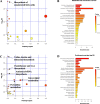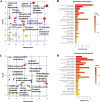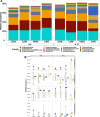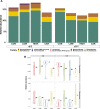Impact of an oligosaccharide-based polymer on the metabolic profiles and microbial ecology of weanling pigs experimentally infected with a pathogenic E. coli
- PMID: 38169416
- PMCID: PMC10759389
- DOI: 10.1186/s40104-023-00956-8
Impact of an oligosaccharide-based polymer on the metabolic profiles and microbial ecology of weanling pigs experimentally infected with a pathogenic E. coli
Abstract
Background: Our previous study has reported that supplementation of oligosaccharide-based polymer enhances gut health and disease resistance of pigs infected with enterotoxigenic E. coli (ETEC) F18 in a manner similar to carbadox. The objective of this study was to investigate the impacts of oligosaccharide-based polymer or antibiotic on the host metabolic profiles and colon microbiota of weaned pigs experimentally infected with ETEC F18.
Results: Multivariate analysis highlighted the differences in the metabolic profiles of serum and colon digesta which were predominantly found between pigs supplemented with oligosaccharide-based polymer and antibiotic. The relative abundance of metabolic markers of immune responses and nutrient metabolisms, such as amino acids and carbohydrates, were significantly differentiated between the oligosaccharide-based polymer and antibiotic groups (q < 0.2 and fold change > 2.0). In addition, pigs in antibiotic had a reduced (P < 0.05) relative abundance of Lachnospiraceae and Lactobacillaceae, whereas had greater (P < 0.05) Clostridiaceae and Streptococcaceae in the colon digesta on d 11 post-inoculation (PI) compared with d 5 PI.
Conclusions: The impact of oligosaccharide-based polymer on the metabolic and microbial profiles of pigs is not fully understood, and further exploration is needed. However, current research suggest that various mechanisms are involved in the enhanced disease resistance and performance in ETEC-challenged pigs by supplementing this polymer.
Keywords: Carbadox; Colon microbiota; Enterotoxigenic E. coli F18; Metabolomics; Oligosaccharide-based polymer; Weaned pigs.
© 2024. The Author(s).
Conflict of interest statement
The authors declare that they have no competing interests.
Figures






References
-
- Ma F, Xu S, Tang Z, Li Z, Zhang L. Use of antimicrobials in food animals and impact of transmission of antimicrobial resistance on humans. Biosaf Health. 2021;03:32–38. doi: 10.1016/j.bsheal.2020.09.004. - DOI
Grants and funding
LinkOut - more resources
Full Text Sources
Research Materials
Miscellaneous

